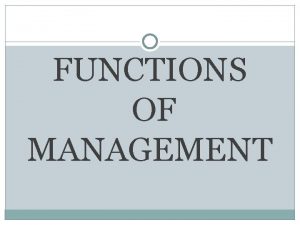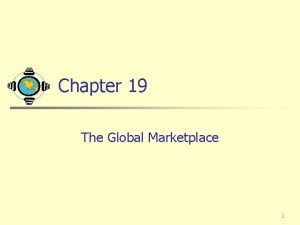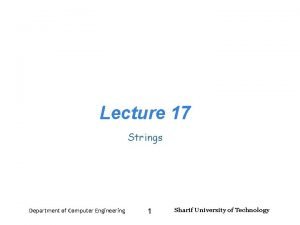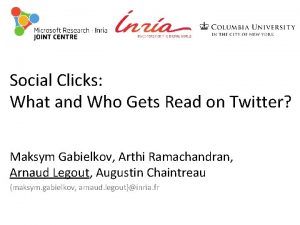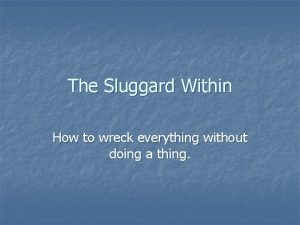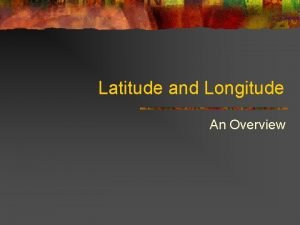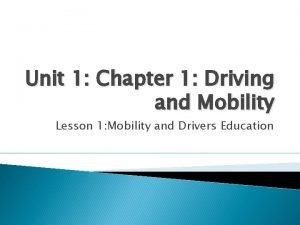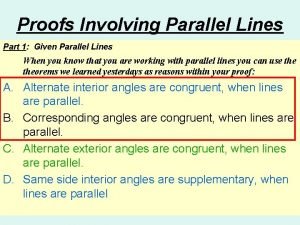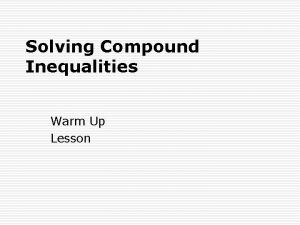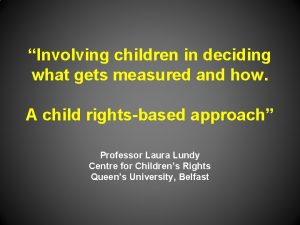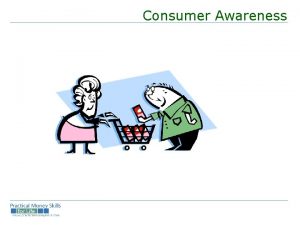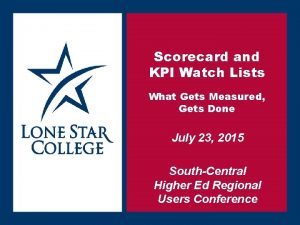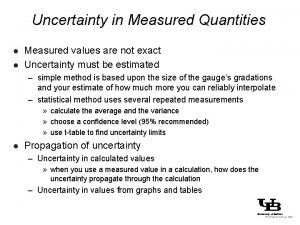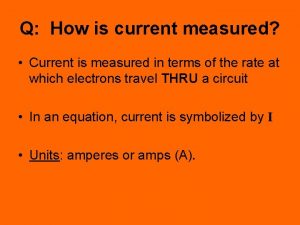Involving children in deciding what gets measured and


















- Slides: 18

“Involving children in deciding what gets measured and how. A child rights-based approach” Professor Laura Lundy Centre for Children’s Rights Queen’s University, Belfast

Seeking children’s perspectives on what matters to them •

Degrees of involvement • Parents are asked about children’s experiences: proxies • Children are asked about their own experiences: passers -by • Children are asked about their lives and this is used by researchers to inform what children should be asked: pilots • Children are given time to think about the issues and are involved in deciding what needs to be measured and how partners

What is a ‘Children’s Rights Based Approach? ’ The activity should: • Further the realisation of children’s human rights. • Human rights standards should guide the process ( e. g. Include children in ways that are meaningful, safe and inclusive) (Arts. 12, 19, 2 of the UNCRC) • Contribute to the development of the capacities of the dutybearers to meet their obligations and of the rights-holders to claim their rights Adapted by Lundy & Mc. Evoy (2012) from the Statement of Common Understanding of Human Rights Based Approaches (UN, 2003)

Two core features of our approach

Working with children as advisors throughout the process Young People’s Advisory Groups Children’s Advisory groups

Building children’s capacity to understand the issues

Example 1: General Comment No. 19 on Public Budgeting (2016) ‘the right to information is essential, because it is the precondition of the child’s clarified decisions’ (UN, 2009)

Violence – ‘what matters to me’ Adults should be absorbing of what children tell them - Tara aged 9

Involving children in deciding what gets measured

Example 1: Children’s enjoyment of their civil and political rights

Example 2: rights in the digital environment for children with disabilities. Participation Protection Provision

Involving children in deciding how it gets asked … (when they are reporting on their own lives)

‘’the language dilemma is mutual” Punch (2002)

Example 1: can’t always use words

Example 2: helping children to form a view

Why involve children? • Hard to defend measuring the effectiveness of children’s rights in a process that excludes them (and is therefore in breach of Art. 12) • Measuring what matters. • Measuring with greater accuracy. • And, importantly, the process can be important as the product - building children’ s capacity to understand claim their rights

References • Lundy, L. & Mc. Evoy, L. (2012) What constitutes a children’s rights-based approach to research? In M. Freeman (ed) Law and Childhood, London, Brill. • Lundy, L. & Mc. Evoy, L. (2012) Children’s Rights-Based Research Methods: Assisting Children to (In)Formed Views, Childhood
 What spooked jem on the night of the radley
What spooked jem on the night of the radley Deciding to marry asl story
Deciding to marry asl story Perencanaan menurut newman
Perencanaan menurut newman Planning is deciding in advance what is to be done
Planning is deciding in advance what is to be done Deciding on the global marketing organization
Deciding on the global marketing organization Consensual vs top down
Consensual vs top down The boy in the striped pyjamas film analysis
The boy in the striped pyjamas film analysis The power of talk who gets heard and why pdf
The power of talk who gets heard and why pdf Difference between string and array
Difference between string and array Differentiate between gets() and puts()
Differentiate between gets() and puts() Social clicks
Social clicks The sluggard craves and gets nothing
The sluggard craves and gets nothing Lines of latitude run from
Lines of latitude run from How are latitude and longitude measured
How are latitude and longitude measured When multiplying and dividing measured quantities
When multiplying and dividing measured quantities How is the hts regulated
How is the hts regulated Proofs involving parallel and perpendicular lines
Proofs involving parallel and perpendicular lines Spring potential and kinetic energy
Spring potential and kinetic energy Write compound inequalities from graphs
Write compound inequalities from graphs



